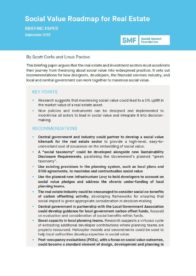This briefing paper argues that the real estate and investment sectors must accelerate their journey from theorising about social value into widespread practice. It sets out recommendations for how designers, developers, the financial services industry, and local and central government can work together to maximise social value.
Key Points
- Research suggests that maximising social value could lead to a 5% uplift in the market value of a real estate asset.
- New policies and instruments can be designed and implemented to incentivise all actors to lead in social value and integrate it into decision-making.
RECOMMENDATIONS
- Central government and industry could partner to develop a social value kitemark for the real estate sector to provide a high-level, easy-to-understand seal of assurance on the embedding of social value.
- A “social taxonomy” could be developed alongside new Sustainability Disclosure Requirements, paralleling the Government’s planned “green taxonomy”.
- Use existing provisions in the planning system, such as local plans and S106 agreements, to maximise and contractualise social value
- Use the planned new Infrastructure Levy to hold developers to account on social value pledges and address the chronic under-funding of local planning teams.
- The real estate industry could be encouraged to consider social co-benefits of carbon offsetting activity, developing frameworks for ensuring that social impact is given appropriate consideration in decision-making
- Central government in partnership with the Local Government Association could develop guidance for local government carbon offset funds, focused on evaluation and consideration of social benefits within funds.
- Boost capacity in local planning teams. Research suggests a virtuous cycle of extracting additional developer contributions where planning teams are properly resourced. Helicopter models and secondments could be used to help local authorities develop expertise in social value.
- Post-occupancy evaluations (POEs), with a focus on social value outcomes, could become a standard element of design, development and planning in real estate. POEs need to be conducted more frequently to capture the long-term social value outcomes.
- Site social value handbooks could be created as standard for all large-scale developments and passed down to new site owners, detailing social value commitments and used as a means for councils and residents to hold developers to account on social value pledges.

DOWNLOAD THE BRIEFING PDF
Kindly sponsored by

